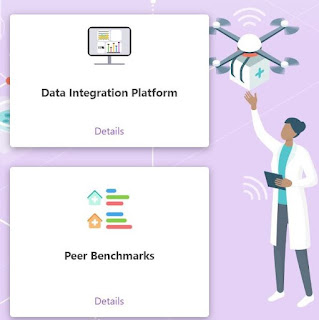Tech Topic Connection: Healthcare Industry
In this post, I will
discuss how the healthcare industry connects to the fundamentals of information
technology covered in TEC101. I will explain how the healthcare industry relates
to the concepts of information technology and computer science, including the
history of computers and how computers operate. Applications and software play
a significant role in the healthcare industry, including database and database
management. Also, I will illustrate how the basic concepts of network
architecture, management, and security influence the healthcare industry.
As mentioned in another previous
post, Computers in the workplace: Healthcare Industry, computers have become
essential and critical to the healthcare industry. The healthcare industry works
in conjunction with information technology. Mechanical ventilators, heart rate
monitoring, tracking patients’ appointments, tracking staff schedules, and
keeping personal information private and away from bad actors are just a few
examples of how the healthcare industry connects to the fundamentals of
information technology. Consequently, Information technology has been
instrumental to the advances in health care. As the overall improvement in technology
increases, so does healthcare capabilities.
Many different functions
within the healthcare industry rely on technology. Indeed,
most machines that connect to an electrical outlet rely, in one way or another,
on technology. Many hospital and clinic machines rely entirely on a modern
computer system’s hardware components and functions. For example, something as familiar
as an x-ray or ultrasound uses programming languages to interpret the images. As
mentioned in the scholarly article, Healthcare
Technology Assessment for Radiology Devices, “This study proposes a program to
assist a clinical engineer in assessing a large variety of radiological devices
(Ultrasound, x-Ray, Mammography, Digital Radiography (DR), and Computed
Radiology (CR) using various Multi-Criteria Decision Making (MCDM) Methods.” (Nabil
et al, 2022). These radiological devices are programmed using different
programming languages. According to Glen Rodriguez from the Nacional Engineering
University of Peru, “C++ would be the most obvious option, but not the cheaper
(in terms of programmer hours). If you are familiar with OpenGL, you could use
Java or Python too.” (2017). The healthcare industries use programs written in different
programming languages to better care for patients. Also, although a programmer
can use different types of language to program healthcare machines and hardware
components, the most important thing is to do it accurately so the devices can
work as expected. Making major mistakes can cost a person’s life. A programmer’s
job is to create a program that executes and can translate the machine 1s and
0s output into human-readable and understandable results. And this is just one
of many ways the healthcare industry relies on modern computer systems and programming.
A deeper analysis of
application software’s role in healthcare shows that software is vital to the
industry. According to a scholarly article, Evaluation of the Attitudes of
Healthcare Professionals Towards Using Evidence-Based Medicine Software in the
Health Care Settings, “Problems of excess paperwork, delays in approving
services, arguments, and claims of over-servicing may arise during healthcare
settings. This is perceived as unwanted for patients and health care
professionals and costly to the health care system.” (Elghriani et al,
2022). Healthcare software should help
alleviate these problems. In a personal interview with an employee of a health
organization that was ranked the best hospital by the U.S. News and World
Reports, the employee confirmed that the software used at the hospital was Epic
Systems and added, “The software is always failing.” (E. Bautista, personal
communication, January 29, 2023). Epic Systems
is a privately held healthcare software. This software alone has over 75% of patient’s
medical records in the United States and less than 4% worldwide in 2022. The
software was founded in 1979, and their statement is, “Epic develops software
to help people get well, help people stay well, and help future generations be
healthier.” (Epic, 2023). Although the software is not perfect, keeping records
of millions of patients in a secured database makes this software essential to
the healthcare industry. The healthcare industry is also heavily regulated regarding
data and database security.
In conclusion, the healthcare
industry has come to rely massively on technology. Technology plays an
essential role in the healthcare industry. In addition, we have seen that network
architecture, software, database management such as SQL and Access, and IT
security influence every aspect of the healthcare industry. And government regulations
such as HIPPA ensure that the healthcare industry, in conjunction with information
technology, keeps patients’ data safe and secure. Health is the most crucial
and top priority in everyone’s life. Therefore, the healthcare industry, combined
with information technology efforts, is helping keep people around the world healthy.
References:
Apps, G.
linkF. T. P. E. O., January 15, 2023, & Comment, P. a. (n.d.). It
careers. IT Careers. Retrieved January 15, 2023, from
https://itcareersbybenny.blogspot.com/
Elghriani,
A. M., Saad, R. M., & Maatuk, A. M. (2022). Evaluation of the Attitudes of
Healthcare Professionals Towards Using Evidence-Based Medicine Software in the
Health Care Settings. 2022 International Conference on Engineering & MIS
(ICEMIS), Engineering & MIS (ICEMIS), 2022 International Conference On,
1–5. https://doi.org/10.1109/ICEMIS56295.2022.9914364
Epic. (2023)
About Us. Retrieved from https://www.epic.com/about
Historical.
CMS. (n.d.).
https://www.cms.gov/research-statistics-data-and-systems/statistics-trends-and-reports/nationalhealthexpenddata/nationalhealthaccountshistorical#:~:text=U.S.%20health%20care%20spending%20grew,spending%20accounted%20for%2018.3%20percent
Nabil, A.
M., Saleh, N., El-Desoky, M., & Shabaan, A. (2022). Healthcare Technology
Assessment for Radiology Devices. 2022 International Symposium on
Multidisciplinary Studies and Innovative Technologies (ISMSIT),
Multidisciplinary Studies and Innovative Technologies (ISMSIT), 2022
International Symposium On, 608–612. https://doi.org/10.1109/ISMSIT56059.2022.9932769
Rodriguez,
Glen. (2017). Re: What programming language should I use for a medical image
application?. Retrieved from: https://www.researchgate.net/post/What-programming-language-should-I-use-for-a-medical-image-application/5a1e39d9f7b67ede9b18715f/citation/download.
Vahid, F.,
& Lysecky, S. (2019). Computing technology for all. zyBooks.




Comments
Post a Comment